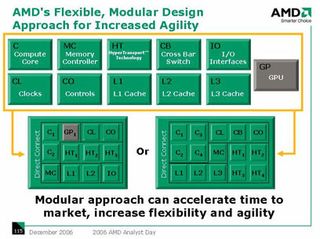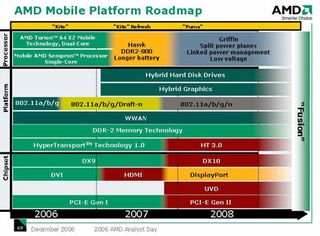AMD questions current multi-core trend
New York (NY) - AMD chief technology officer Phil Hester voiced concerns over the implications of the trend to integrate an increasing number of similar cores into one package. The company indicated that it could part with a strategy of using dozens of cores in one CPU and would turn to developing "Accelerated Processing Units," short APUs instead.
We just learned about the benefits of having multiple cores in one processor package. If you are using multithreaded software, you could see not only substantial performance jumps with dual- or quad-core processors, but also a power consumption that is about level or less than what we have seen in recent years. At its annual meeting with financial analysts today, the company however warned that the excitement for multi-core may be somewhat short-lived.
"In the early 2000s, we became side-tracked with the Gigahertz race, which has been a mistake." The same could happen with multi-core processors, Hester stated: "The industry can be side-tracked by the number of cores in CPUs." Claiming that "homogenous multi-core" will become "increasingly inadequate" over the next few years, AMD is putting its bets on a new type of processor, which it calls APU. An APU is based on a building-block idea that was first brought to live with the integrated memory controller: Similarly, AMD plans to leverage ATI's graphics technology as an integral part of future (heterogeneous) multi-core processors that are believe to bring more performance and increased power efficiency.

APU layout
AMD typically refers to this concept currently as "Fusion". Roadmaps presented at the event show that the company will introduce such a chip in the mobile computing space in the 2009 time frame. However, the company plans to deploy is concept in what Hester called a "collection of special purpose hardware" ranging from the PDA to peta-Flop capable devices. The key idea behind that thought is that the integration of a GPU can scale from entry-level to high-end devices because of the different capabilities of a graphics chip. On the one side, a GPU is just that - a graphics processing unit. But because of its enormous number crunching capability, you could see a (different) Fusion processor with a GPU that would primarily act as "stream processor" that is aimed at floating-point-heavy applications in deskside supercomputers as well.
If AMD has its way, than we could be going from a universal computing device today to very specialized and targeted hardware by 2009 and beyond. Fusion is one of the first applications that will leverage AMD's Torrenza platform and a new trend that the company describes as "accelerated processing era." Details of specific products have not been announced.
2007/2008 roadmap: DDR3 coming to the desktop in 2008
Stay on the Cutting Edge
Join the experts who read Tom's Hardware for the inside track on enthusiast PC tech news — and have for over 25 years. We'll send breaking news and in-depth reviews of CPUs, GPUs, AI, maker hardware and more straight to your inbox.
AMD also provided a few more details about upcoming products. On the server side, the company said it will introduce the "Shanghai" processor in early 2008, as an update of the "Barcelona" quad-core, which is scheduled for a mid-2007 release. Barcelona will be the first CPU to use Hypertransport 3, while it will keep using DDR2 memory and maintain a power envelope between 68 and 120 watts.
On the desktop there were several new announcements for 2008: The company will transition to socket AM3, which will be using DDR3 memory. Single-, dual- and quad-core will cover the company's product portfolio from entry-level machines to enthusiast computers. For 2007, we will see the introduction of Hypertransport 3, a continued offering (and "investment", according to AMD) into the dual-socket technology QuadFX as well as new chipsets and graphics: The graphics unit is set to introduce its first DirectX10 graphics chip codenamed "R600," which will go head-to-head with Nvidia's GeForce 8800 series. DirectX 10 will be supported by AMD chipsets later in 2007, the company said.



There were some interesting mobile announcements as well. AMD will be introducing new power-optimized graphics solutions for notebooks that adapt to scenarios in which a notebook is running on different power sources. A technology which it calls "dynamic graphics mode" will allow a notebook to use a discrete graphics card when connected to power plug and shift to integrated graphics when on battery mode. This technology, of course, requires that a mobile computer carries both integrated and discrete graphics in one case.
Related articles:
AMD's "Fusion" processor to merge CPU and GPU
AMD's Fusion: Revolution or dangerous adventure?
AMD introduces 65 nm processors
AMD aims to reclaim CPU crown with 2007 quad-core
AMD jumps into top-10 of world's largest semiconductor companies
Most Popular

